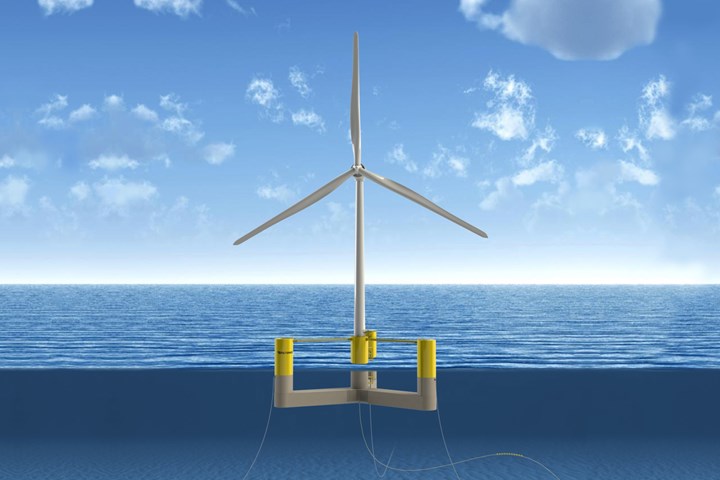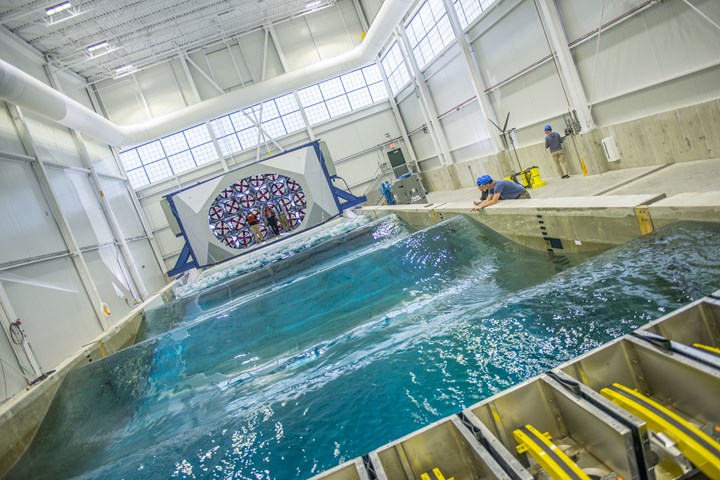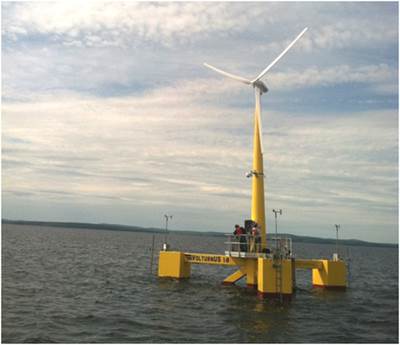UMaine develops collaborative floating offshore wind demo project
The floating offshore wind demonstration project will reduce Maine’s overdependence on imported fossil fuels, produce more than $150 million in total economic output and create hundreds of jobs.

VolturnUS, UMaine's patented floating hull technology. Source | University of Maine
The University of Maine (UMaine, Orono, Maine) reported on August 5 that it will collaborate with New England Aqua Ventus, LLC (NEAV), a joint venture between Diamond Offshore Wind (DOW) — a subsidiary of Mitsubishi Corp. (Tokyo, Japan) and Diamond Generating Corp. (DGC, Los Angeles, Calif., U.S.)— and RWE Renewables (Essen, Germany), the second largest company in offshore wind globally, to develop UMaine’s floating offshore wind technology demonstration project off the coast of Maine.
As the developer, NEAV will own and manage all aspects of permitting, construction and assembly, deployment and ongoing operations for the project. UMaine’s Advanced Structures and Composites Center (ASCC) will continue with design and engineering, research and development and post-construction monitoring.
According to the university, the project will consist of a single semi-submersible concrete floating platform that will support a commercial 10-12 megawatt wind turbine, and will be deployed in a state-designated area two miles south of Monhegan Island and 14 miles from Maine’s coast. The purpose of the demonstration project, says UMaine, is to further evaluate the floating technology, monitor environmental factors and develop best practices for offshore wind to coexist with traditional marine activities. It is said it will supply clean, renewable electricity to the Maine grid. Construction, following all permitting, is expected to be completed in 2023.
Senators Susan Collins and Angus King and Representatives Chellie Pingree and Jared Golden issued a joint statement on the partnership announcement: “For generations, Maine has been a national leader when it comes to using our natural resources sustainably to create jobs, protect our environment and power our economy. The University of Maine’s floating deep-water offshore wind project carries on that tradition. We have strongly supported UMaine’s development of the Aqua Ventus project. We are proud to see the project’s progress and applaud the $100 million public-private partnership launched today, which will accelerate UMaine’s development of its innovative technology and create jobs. Maine’s offshore wind resource potential is 36 times greater than the state’s electricity demand, making this project so significant for Maine’s clean energy future.”
UMaine says an immediate priority for the new development team is to engage with the fishing industry, other maritime users, coastal communities and other interested parties on how to ensure this new renewable energy source can optimally provide economic growth to Maine and work with maritime industries.
The project is projected to produce more than $150 million in total economic output.
Since 2008, the university says it has researched floating offshore wind technology as a solution to Maine’s overdependence on imported fossil fuels. After winning funding from the U.S. Department of Energy (DOE), the university worked with construction firm Cianbro (Pittsfield, Maine) in 2013 to build and deploy the first grid-connected offshore wind turbine in the U.S., a one-eighth scale prototype of its VolturnUS floating hull technology which used a composite tower and blades. The success of the project, contends UMaine, led to additional funding from the DOE to further advance the VolturnUS technology, which has been issued 43 patents to date. The university and Cianbro sought to partner with a world-class offshore wind developer to further demonstrate this technology on a commercial scale. UMaine says it will continue to own its VolturnUS floating hull intellectual property and license it to NEAV for this project. More importantly, the current prototype’s rotor blades takes advantage of composites. UMaine says future developments could include a composite tower as well.
Diamond Offshore Wind and RWE Renewables, with years of collective offshore energy experience, will invest $100 million to build the project and help demonstrate the technology at full scale. Combined, UMaine notes that the two new partners are responsible for nearly a quarter of the world’s offshore wind capacity.
“We are pleased to see the University of Maine continuing to make progress and that new private sector partners recognize the great potential of this project,” says Daniel Simmons, assistant secretary of energy efficiency and renewable energy for the U.S. DOE. “This complements the investment of research, development and demonstration funding from DOE to advance innovation in a floating design for offshore wind.”
Under the Mills administration and with a long history of bipartisan support, Maine has moved boldly ahead on renewable energy and offshore wind development, including enacting legislation authorizing approval by the Maine Public Utilities Commission of the power purchase contract for Aqua Ventus, and initiating a study of the port at Searsport as a potential site to support and develop offshore wind. The governor also accepted the invitation for Maine to join the Bureau of Ocean Energy Management Gulf of Maine Intergovernmental Renewable Energy Task Force, along with New Hampshire and Massachusetts, which is charged with facilitating coordination related to renewable energy activities in federal waters in the Gulf of Maine.

Wind-Wave Ocean Engineering Laboratory at the University of Maine. Source | University of Maine
“This is a significant milestone for the University of Maine, the offshore wind research team and the state of Maine,” says UMaine president Joan Ferrini-Mundy. “As Maine’s research university, UMaine is continually advancing its broad land grant, sea and space grant mission. The path from fundamental research to economic realization is complex, and success takes incredible innovation, persistence and strategic partnerships. Many faculty, staff and students have participated in the development of this technology and will continue to support the energy and marine economy as this project transitions to the private sector. This collaboration exemplifies our role and commitment to creating and supporting the future of Maine.”
According to the university, NEAV will continue to involve Maine companies in permitting, construction and assembly, deployment, and ongoing operations and maintenance of the project. In addition, NEAV has committed to working with the University of Maine on research, development and design to take the technology elsewhere in the U.S. and the world. The concrete hulls are designed to be built in communities adjacent to potential projects, generating local construction jobs and other benefits during the building and assembly phase.
Further, the developers will work with the University of Maine System, the Maine Community College System and Maine Maritime Academy to attract K–12 students to science, engineering and business programs, prepare college students and help to create a skilled workforce in Maine with the technical skills necessary to support offshore wind development and operation.
The project is projected to produce more than $150 million in total economic output and create hundreds of Maine-based jobs during the construction period.
Related Content
Drag-based wind turbine design for higher energy capture
Claiming significantly higher power generation capacity than traditional blades, Xenecore aims to scale up its current monocoque, fan-shaped wind blades, made via compression molded carbon fiber/epoxy with I-beam ribs and microsphere structural foam.
Read MorePlant tour: ÉireComposites, Galway, Ireland
An in-house testing business and R&D focus has led to innovative materials use and projects in a range of markets, from civil aerospace to renewable energy to marine.
Read MoreForvia brand Faurecia exhibits XL CGH2 tank, cryogenic LH2 storage solution for heavy-duty trucks
Part of its full hydrogen solutions portfolio at IAA Transportation 2022, Faurecia also highlighted sustainable thermoplastic tanks and smart tanks for better safety via structural integrity monitoring.
Read MoreJEC World 2022, Part 3: Emphasizing emerging markets, thermoplastics and carbon fiber
CW editor-in-chief Jeff Sloan identifies companies exhibiting at JEC World 2022 that are advancing both materials and technologies for the growing AAM, hydrogen, automotive and sustainability markets.
Read MoreRead Next
VolturnUS floating wind turbine celebrates one year of service
The VolturnUS 1:8 scale floating wind turbine off the coast of Maine has successfully withstood 18 severe storms in its one year of service.
Read MoreCW’s 2024 Top Shops survey offers new approach to benchmarking
Respondents that complete the survey by April 30, 2024, have the chance to be recognized as an honoree.
Read MoreFrom the CW Archives: The tale of the thermoplastic cryotank
In 2006, guest columnist Bob Hartunian related the story of his efforts two decades prior, while at McDonnell Douglas, to develop a thermoplastic composite crytank for hydrogen storage. He learned a lot of lessons.
Read More











.jpg;maxWidth=300;quality=90)














